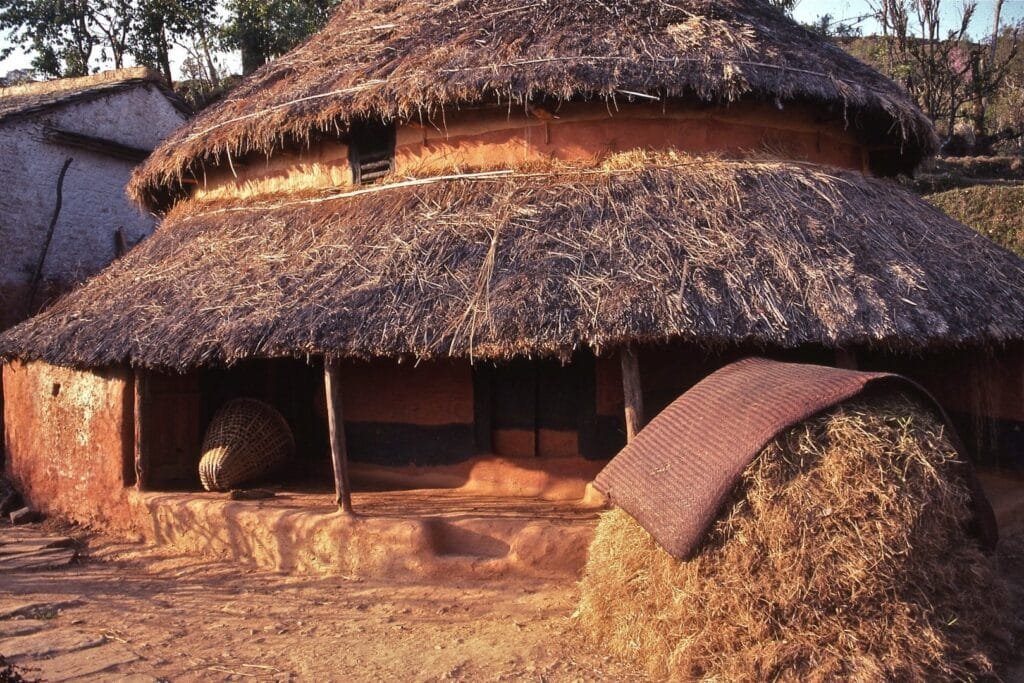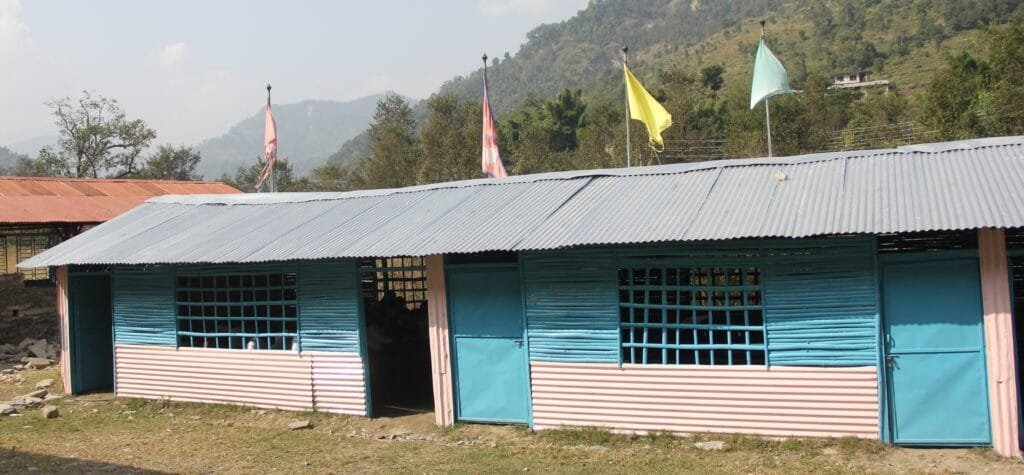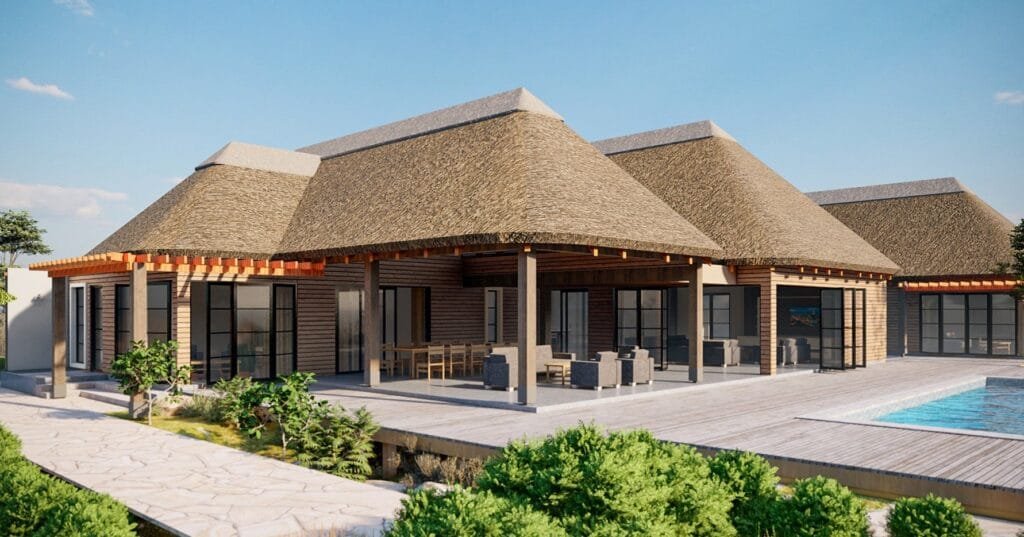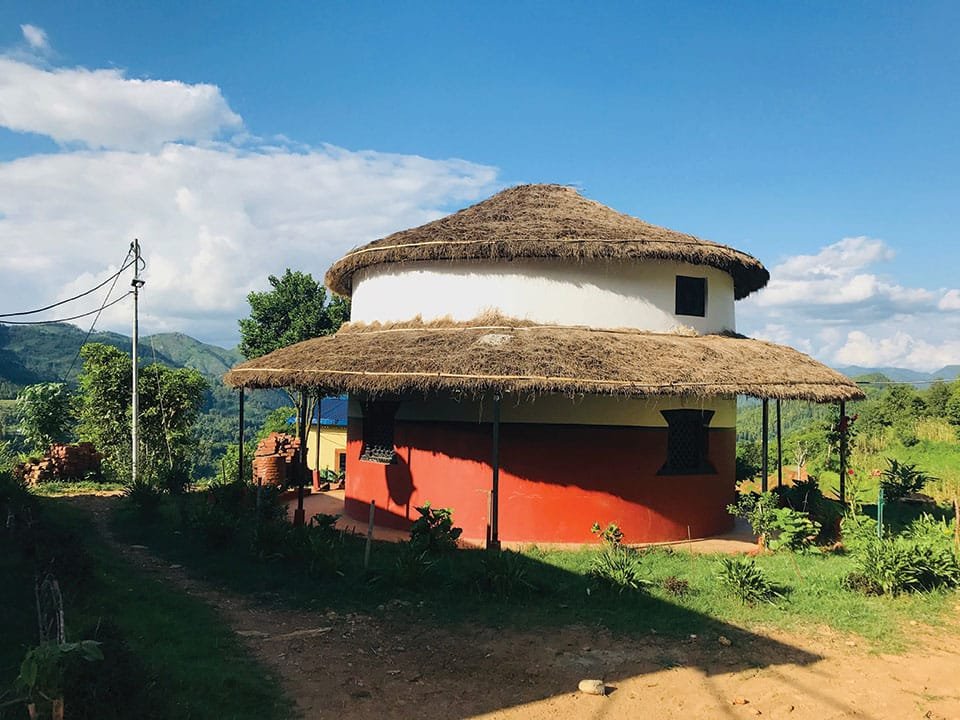Traditional thatched roofs (khaki Chhaana) have long been essential to Nepal’s rural landscape. Composed of renewable materials like straw, bamboo, and reeds, they represent an eco-friendly option. However, after the 2015 earthquake, the government promoted the use of tin roofs for rebuilding homes. While this was a quick fix, it has led to significant environmental, economic, and health problems. This article explores why we should continue using traditional roofing methods, improve them with modern techniques, and consider their many benefits.

The Value of Traditional Thatched Roofs
Cultural Heritage
Thatched roofs are not only practical in Nepal; they are also a vital aspect of the country’s cultural heritage. For centuries, people in rural areas have constructed homes using local materials, and this connection to the land and tradition has been passed down through generations. Thatched roofs convey the stories of local craftsmanship and the relationship between people and nature. By preserving these roofs, we uphold Nepal’s cultural identity.
Environmental Sustainability
Traditional roofing materials are renewable and biodegradable. Straw, bamboo, and reeds are naturally sourced and can be cultivated sustainably, making thatched roofs environmentally friendly. In contrast, materials such as tin and plastic require energy-intensive production methods and are non-biodegradable, contributing to long-term environmental damage. Choosing local, renewable materials lowers the carbon footprint and aids in preserving the planet.
Practical Benefits
Thatched roofs are ideal for Nepal’s varied climate. These roofs naturally insulate homes, keeping them cool during the hot summer months and warm in the chilly winters. Unlike tin roofs, which absorb heat and make homes extremely hot, thatched roofs maintain a comfortable temperature without requiring energy-consuming heating or cooling systems. This natural temperature regulation enhances comfort and helps families save on energy bills.

The Threats to Traditional Thatched Roofs Practices
Fire Hazards
One of the main concerns with thatched roofs is that they are prone to fire. However, there are modern solutions to make thatched roofs safer. Fireproofing treatments can significantly reduce the risk of fire. Yet, many people are unaware of these options and may choose tin roofs as a safer alternative. The lack of access to affordable fireproofing solutions has made this a more significant issue, leading some to replace thatched roofs unnecessarily.
Labor and Maintenance
Building and maintaining thatched roofs requires a lot of skill and effort. Harvesting the materials, preparing them, and making the roof can take time. The younger generation often prefers the convenience of modern materials like tin, which seem more straightforward to install. This shift away from traditional skills can lead to a loss of valuable knowledge in rural communities. However, with the right training programs and government incentives, people can learn how to properly maintain thatched roofs, making them a sustainable option for the future.
Economic Influence
The rise of the roofing mafia is another reason that tin roofs are becoming more popular. Certain groups profit from importing expensive roofing materials like tin and plastic. These groups often prioritize profit over sustainability, taking advantage of disaster recovery efforts after the earthquake to push their products. As a result, local, sustainable roofing options are sidelined in favor of imported materials. This increases the cost of building homes and contributes to Nepal’s growing trade deficit. It weakens the national economy and reduces local employment opportunities in rural areas.

The Negative Impacts of Tin and Plastic Roofs
Human Health
Tin roofs are problematic for human health. They absorb and retain heat, making homes incredibly hot during summer. In winter, the heat escapes, and the interiors become unbearably cold. This extreme temperature fluctuation can cause respiratory problems, dehydration, and other health issues. In contrast, thatched roofs provide a more stable and comfortable indoor climate, benefiting residents’ overall health.
Food Security
In rural areas, homes often serve as storage spaces for grains and seeds. The extreme heat from tin roofs can spoil these stored foods, threatening food security. With thatched roofs, the cooler temperature inside helps preserve food supplies, reducing waste and keeping resources intact for extended periods.
Environmental Degradation
As mentioned earlier, tin and plastic are non-biodegradable. These materials contribute to long-term environmental harm, especially when they are discarded. Making tin involves mining, which creates a negative environmental impact by causing habitat destruction and increasing carbon emissions. Thatched roofs, however, use renewable and biodegradable materials, causing minimal environmental harm.
Economic Drain
Tin roofs are expensive to purchase and install. Rural families often struggle to afford these materials, especially in areas with limited market access. The cost of these imported materials drains money from local economies. In addition, the decline of traditional roofing practices reduces the demand for local materials and labor, resulting in fewer job opportunities in rural communities.

Solutions for Preserving and Modernizing Thatched Roofs
Fireproofing Techniques
Fireproofing solutions for thatched roofs should be promoted to reduce the fire risk. Simple treatments can significantly increase their safety without compromising their aesthetic or functionality. Training programs in rural areas can help homeowners understand these treatments and encourage them to maintain their roofs properly.
Durability Improvements
Another solution is to improve the durability of thatched roofs. Reinforced bamboo frameworks and pest-resistant coatings can increase their lifespan. Additionally, clay layers can be added to make them more waterproof. These improvements can reduce maintenance costs and make thatched roofs more reliable in the long term.
Government Support
The government should provide financial incentives to encourage fireproofing treatments and other improvements for thatched roofs. By offering subsidies and grants, the government can make it easier for rural communities to maintain their traditional roofing practices. Additionally, policies encouraging local materials would help promote sustainability and reduce dependency on imported tin and plastic materials.
Educational Programs
Workshops and school programs can help raise awareness about the importance of traditional roofing and sustainable construction methods. Educating both young and old about the benefits of renewable materials can foster a stronger sense of cultural pride and environmental responsibility.
Community and NGO Initiatives
Local communities, NGOs, and researchers can collaborate on projects promoting sustainable roofing materials. These initiatives can serve as models for other regions, showing how to balance tradition with modern solutions. NGOs can help create a more sustainable future for Nepal by supporting eco-friendly projects.
Economic and Social Benefits of Returning to Traditional Thatched Roofs
Strengthening the Local Economy
Using local materials for roofing supports the local economy. Sourcing materials like bamboo and straw generates jobs in rural areas. It also reduces Nepal’s reliance on imported roofing materials, strengthening the national economy by reducing the trade deficit.
Sustainability
The use of renewable and biodegradable materials aligns with global trends toward sustainability. Eco-friendly practices are becoming more important worldwide, and Nepal can lead the way by promoting traditional roofing methods. This would contribute to global sustainability goals while preserving the country’s cultural heritage.
Health and Food Security
Traditional roofs help preserve residents’ health by regulating indoor temperatures. More astonishing homes also preserve food supplies, ensuring food security in rural areas. This contributes to a healthier and more self-sufficient population.
Cultural Pride
Reviving traditional roofing techniques helps foster pride in Nepal’s rich cultural history. It encourages younger generations to take pride in their heritage and helps preserve the country’s traditions for future generations.
Comparison of Traditional Thatched Roofs and Tin Roofs
| Feature | Thatched Roofs | Tin Roofs |
| Temperature Regulation | Naturally cool in summer, warm in winter | Traps heat in summer, loses warmth in winter |
| Environmental Impact | Fully renewable, biodegradable | Non-renewable, high environmental cost |
| Noise Control | Quiet during rainstorms | Noisy and disruptive during rainfall |
| Aesthetic Value | Blends with natural surroundings | Often stark and out of place in rural settings |
| Food Storage | Helps preserve food grains for longer periods due to natural cooling | High heat causes food grains to spoil quickly |
| Health Benefits | Maintains a stable and comfortable indoor temperature, reducing heat-related health issues | Extreme temperature fluctuations can cause dehydration, heat strokes, and respiratory problems |
| Cultural Heritage | Represents a vital part of local culture and craftsmanship | Often seen as foreign and disconnected from local traditions |
| Cost-Effective | Local materials are inexpensive and easily sourced | Tin roofs are costly to purchase and install, especially in rural areas |
| Sustainability | Made from renewable, biodegradable materials like straw, bamboo, and reeds | Requires energy-intensive production and is non-biodegradable, adding to waste and pollution |
| Durability | Can last many years if maintained properly and with modern improvements | Prone to corrosion, particularly in areas with high humidity or salt air |
Conclusion
In conclusion, using traditional thatched roofs in Nepal offers numerous environmental, economic, and health benefits. While tin roofs were promoted after the 2015 earthquake as a quick fix, they have led to health problems, environmental degradation, and economic challenges. Preserving and improving traditional roofing practices can safeguard Nepal’s cultural heritage, reduce environmental harm, and promote a more sustainable future. Traditional roofs can be made more durable and safe through government support, community initiatives, and modern fireproofing techniques. Collective action will preserve Nepal’s sustainable, culturally rich, and environmentally friendly future.





